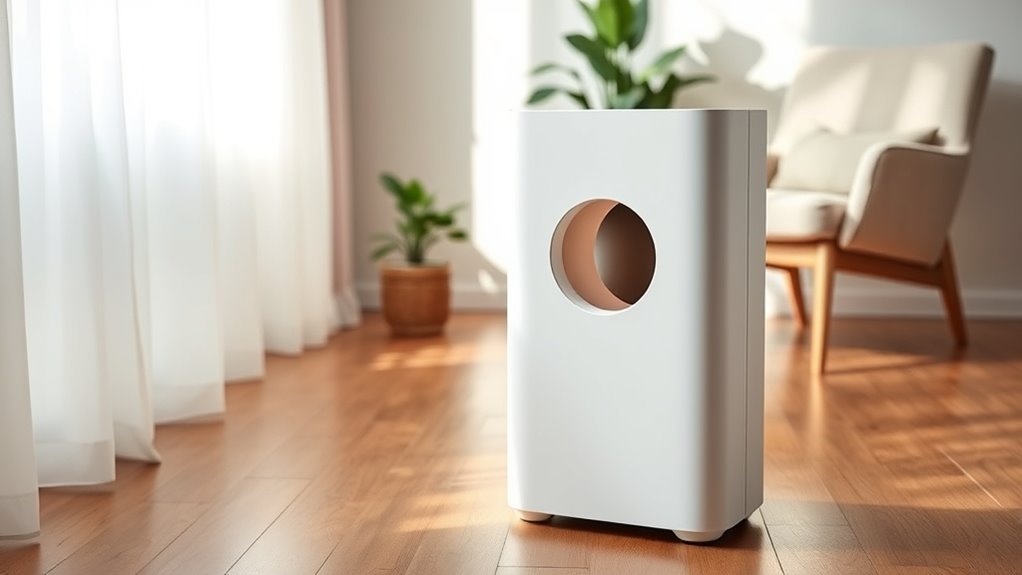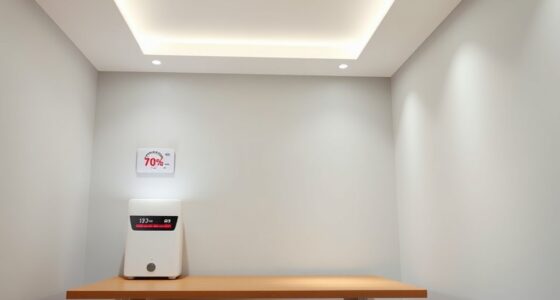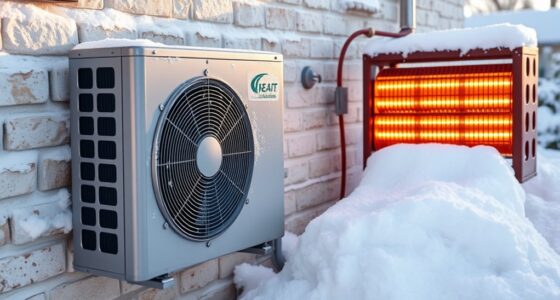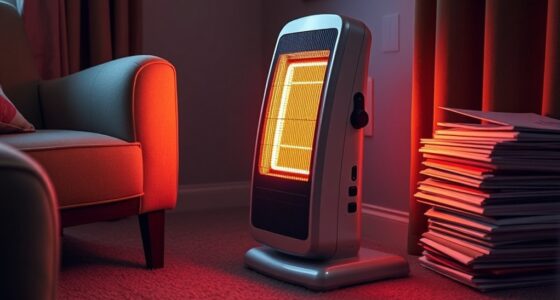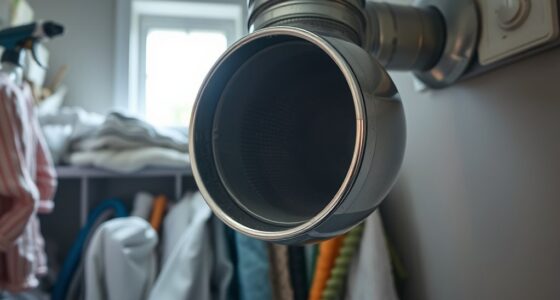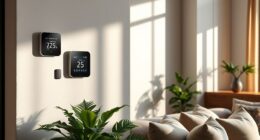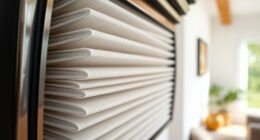To place your air purifier correctly, choose a central, open spot away from walls, furniture, and clutter that could block the inlet or outlet. guarantee it’s positioned at chest or waist level for better airflow and filter efficiency. Keep the area clear of dust sources and avoid placing it near pollution hotspots like busy streets or kitchens. Proper placement boosts performance and prolongs your device’s lifespan—learn more about optimizing your setup below.
Key Takeaways
- Position the purifier in a central, open area away from walls and furniture to ensure unobstructed airflow.
- Keep the inlet and outlet free from clutter, furniture, or curtains to prevent airflow blockages.
- Place the device at chest or waist level for optimal air circulation and pollutant capture.
- Avoid placing near pollution sources like busy streets, kitchens, or dusty areas to maximize efficiency.
- Regularly inspect and reposition the purifier if airflow is restricted or performance declines.
Understanding the Importance of Proper Placement
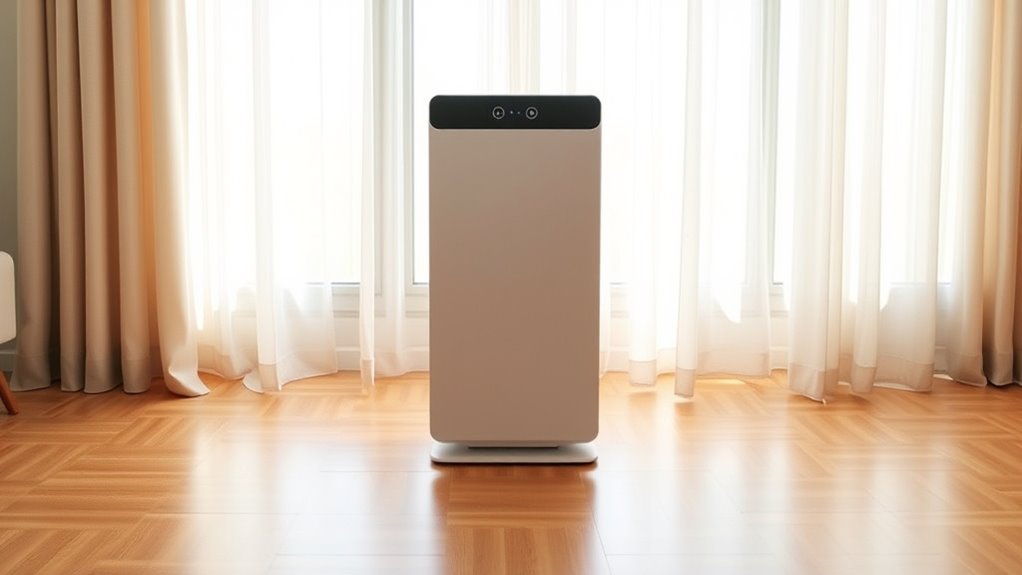
Proper placement of your air purifier is essential to maximize its effectiveness. Position it where air quality sensors can accurately detect pollutants, ensuring the device responds promptly to changes. Keep the purifier away from walls or furniture that might block airflow, which can hinder its ability to clean the air efficiently. Placing it in a central location allows for even distribution of purified air throughout the room. Regular filter replacement is crucial; a clogged filter reduces airflow and diminishes performance. When the purifier is correctly placed, it can better monitor air quality and maintain ideal operation. Enhancing customer interactions through proper placement ensures more accurate readings and better service. Remember, the right spot helps the device work smarter, not harder, keeping your environment healthier and your filters functioning at their best.
Keeping the Inlet Clear and Unobstructed
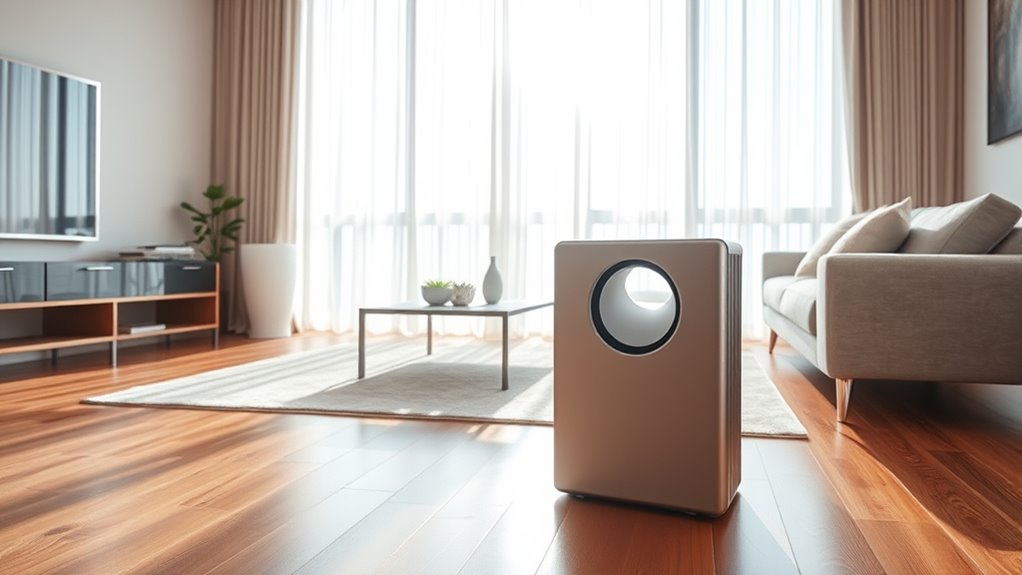
Ensuring the air purifier’s inlet stays clear allows for ideal airflow and pollutant removal. When the inlet is blocked, the unit strains to pull in air, reducing efficiency and possibly increasing noise levels. Regular filter replacement is key, as dirty filters can restrict airflow and make your purifier work harder. Keep a safe distance from furniture, curtains, or clutter that can obstruct the inlet. Proper placement and airflow optimization help your purifier run quietly and effectively, ensuring cleaner air without unnecessary disruptions. Check the inlet area often, especially after cleaning or moving furniture. Clear access helps your purifier run quietly and effectively, ensuring cleaner air without unnecessary disruptions. Proper placement and maintenance maximize your unit’s performance and lifespan.
Choosing the Optimal Location in Your Space

To get the most out of your air purifier, you need to choose the right spot in your space. Consider ventilation strategies—placing it near fresh air sources or in areas with high airflow helps maximize filtration. Avoid corners or enclosed spaces that limit circulation. Think about aesthetic considerations too; select a location that blends with your decor and doesn’t disrupt the room’s appearance. A spot at least a few feet away from walls and furniture ensures proper airflow and prevents obstructions. Positioning your purifier in a central location can improve coverage across the room. Keep in mind that the right placement enhances both efficiency and visual harmony, creating a healthier environment without sacrificing style. Proper cookie management in your browsing environment also supports a smoother online experience when researching or shopping for air purifiers.
Avoiding Common Placement Mistakes
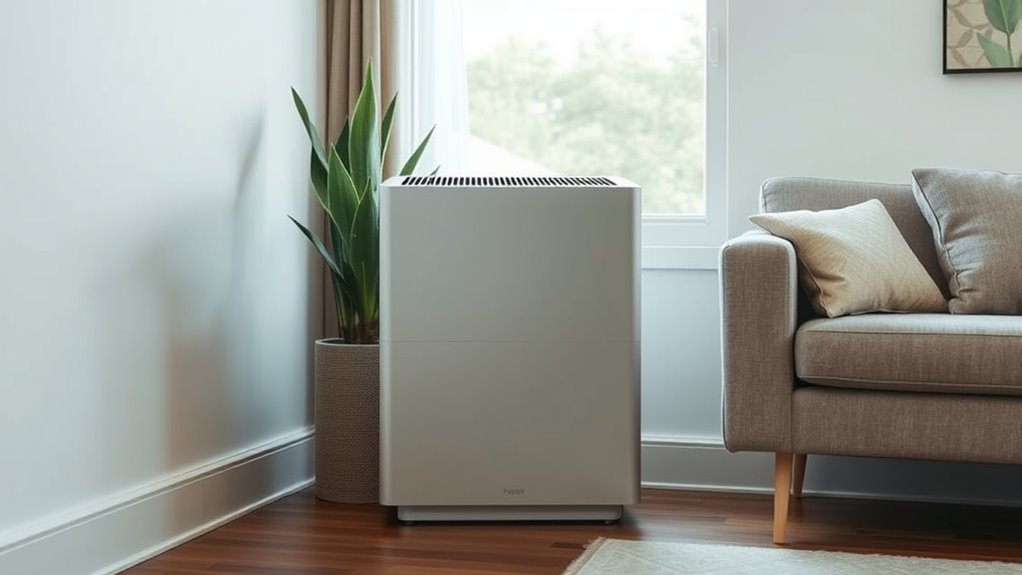
Even if you’ve chosen a great spot for your air purifier, common placement mistakes can undermine its effectiveness. Placing it too close to walls or furniture can block the inlet, reducing airflow and filtering efficiency. Make sure you maintain easy access for regular filter maintenance; neglecting this can lower air quality and strain the unit. Avoid placing the purifier near sources of noise or in high-traffic areas if noise reduction matters to you, as this can lead to unnecessary disturbance. Keep it at an appropriate height—ideally chest or waist level—to maximize circulation. Also, don’t forget to check that nothing obstructs the air intake or outlet. Proper placement combined with regular filter maintenance ensures your purifier works at its best while minimizing noise and maintaining clean indoor air. Remember, understanding types of cookies can help you optimize your browsing experience while researching the best placement tips.
Positioning Relative to Dust and Pollutant Sources
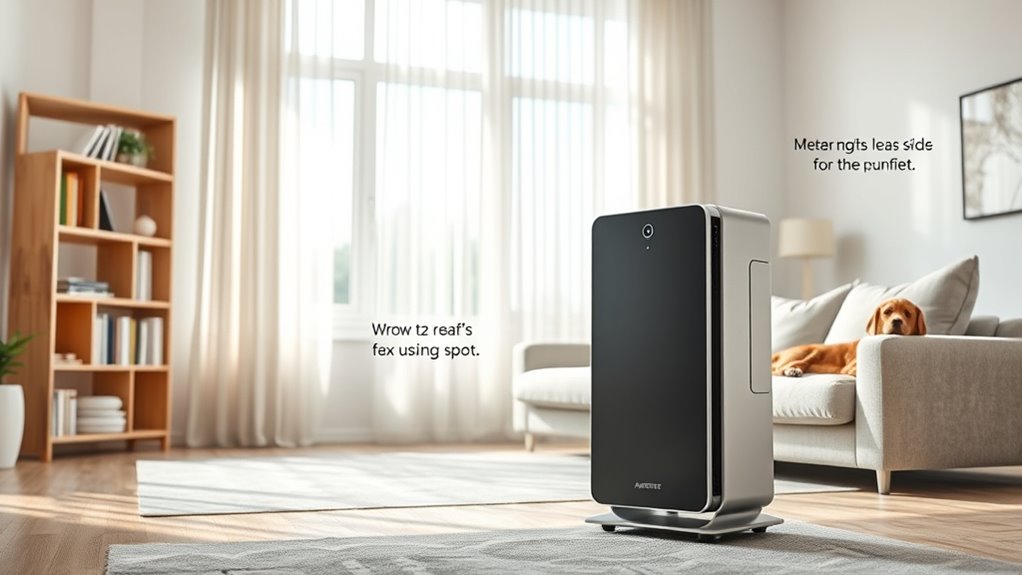
You should keep your air purifier away from dust sources like carpets or cluttered areas to prevent it from pulling in excessive particles. Placing it near pollution sources, such as busy windows or kitchens, can reduce its effectiveness. Position the unit thoughtfully to maximize its ability to clear the air efficiently. Additionally, proper placement can help ensure the purifier’s performance and lifespan are optimized for ongoing use.
Keep Clear of Dust Sources
Have you considered how placing an air purifier near dust sources can reduce its effectiveness? If it’s too close to areas like cluttered shelves or dusty carpets, dust can quickly overwhelm the filter, leading to more frequent filter replacements. It also increases noise levels, making it disruptive. To optimize performance, keep the purifier away from dust-prone zones and high-traffic areas. Here’s a visual guide:
| Dust Source Location | Recommended Distance |
|---|---|
| Cluttered shelves | At least 3-4 feet away |
| Carpets or rugs | Maintain distance to avoid dust buildup |
| Entryways or windows | Keep clear to prevent dust influx |
Keeping the purifier clear of dust sources ensures better air quality, quieter operation, and longer-lasting filters. Additionally, proper device placement can enhance the overall efficiency of your air purifier.
Place Away From Pollution
To maximize an air purifier’s effectiveness, it’s essential to position it away from pollution sources such as busy streets, smoking areas, or industrial zones. Placing the purifier near these sources can draw in higher concentrations of pollutants, reducing overall air quality. Instead, choose a location where pollution levels are lower, like a central room away from windows facing busy streets or smoking zones. This helps guarantee the purifier works efficiently by filtering cleaner air and preventing it from constantly battling external pollution. Keep in mind that proximity to pollution sources can overwhelm the device’s capacity, making it less effective. Proper air purifier placement**** helps maintain better indoor air quality and ensures your air purifier performs at its best.
Maintaining Adequate Airflow Around the Device
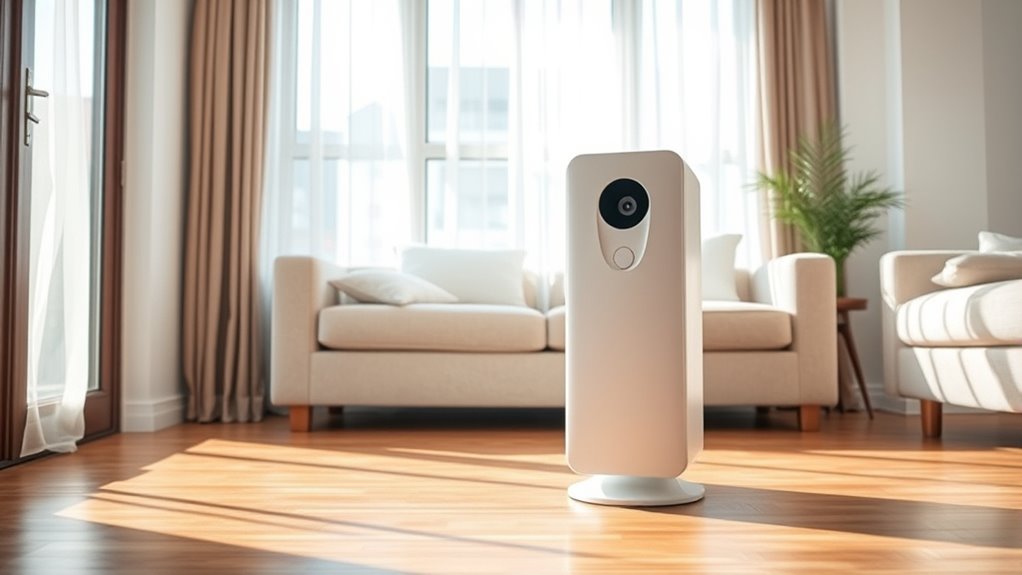
Ensuring proper airflow around your air purifier is essential for ideal performance. When airflow is unrestricted, your device filters air efficiently and maintains low noise levels. To optimize airflow, consider these steps:
- Keep the purifier at least 3 feet away from walls and furniture.
- Regularly replace filters to prevent blockages that hinder airflow.
- Avoid placing objects near the inlet or outlet, which can cause noise and reduce effectiveness.
- Confirm vents are clear and unobstructed to maintain consistent air circulation.
- Position the purifier in an open area that allows for adequate airflow, avoiding tight corners or enclosed spaces.
Considering Room Size and Air Circulation Patterns

Proper placement of your air purifier also depends on the size of the room and how air moves within it. You need to consider ventilation patterns to ensure clean air circulates effectively. In larger rooms, position the purifier closer to the center or near sources of pollution, like a smoking area or pet zone. Keep in mind that the room layout can create air currents that influence circulation; avoid placing the device in corners or behind furniture where airflow is restricted. Open spaces promote better air movement, helping the purifier capture airborne pollutants more efficiently. Additionally, understanding the air circulation patterns within your space can help you choose a spot that maximizes the device’s effectiveness and maintains fresh, healthy air throughout the room.
Tips for Regularly Checking and Adjusting Placement
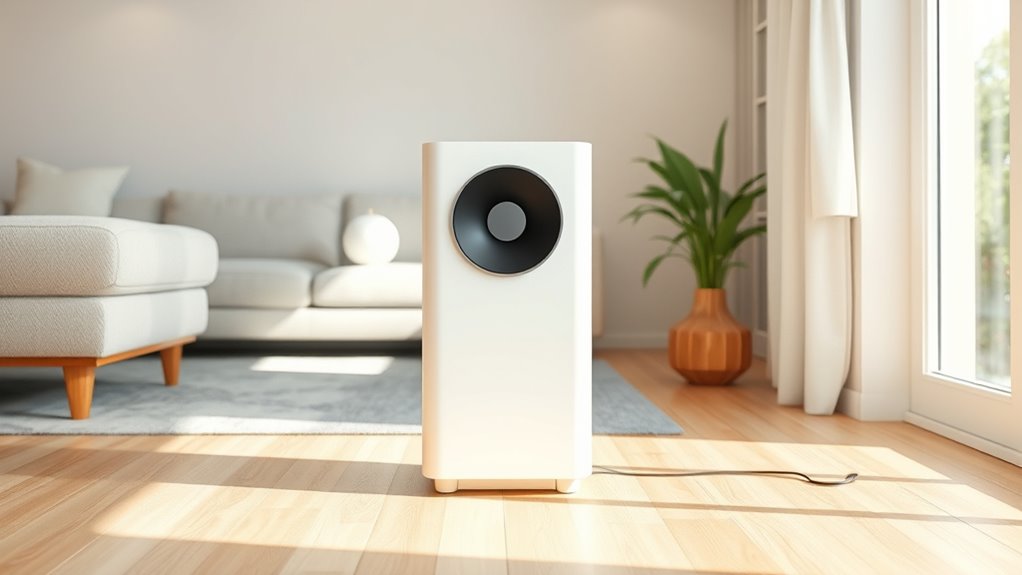
Regularly checking and adjusting your air purifier’s placement helps maintain its efficiency. To guarantee optimal performance, consider these steps:
- Inspect the filter for dust buildup and perform filter maintenance as needed.
- Move the unit slightly if you notice increased noise levels, which can indicate poor placement.
- Ensure the purifier isn’t blocking the inlet or outlet, which can reduce airflow and filter effectiveness.
- Rotate or reposition the unit to avoid obstructions and improve air circulation, enhancing both filter performance and noise reduction.
Frequently Asked Questions
How Often Should I Reposition My Air Purifier for Optimal Performance?
You should reposition your air purifier every 1 to 3 months to optimize airflow and maintain effective air cleaning. Regular placement adjustments help prevent airflow blockage and guarantee the device functions efficiently. Keep an eye on airflow optimization by checking if the purifier’s filters stay clean and if the air feels fresher. Repositioning frequently also allows you to find the best spot for maximum coverage and performance.
Can Placing the Purifier Near Windows Affect Its Effectiveness?
Placing your air purifier near windows can reduce its effectiveness because of window placement and airflow interference. When positioned too close to windows, drafts and outdoor pollutants can bypass the purifier or disrupt airflow, making it less efficient. To maximize performance, keep it a few feet away from windows, ensuring unobstructed airflow. This way, your purifier can effectively clean indoor air without interference from outside sources.
Is It Better to Keep Doors Open or Closed Around the Purifier?
You should keep doors open around your air purifier to improve airflow and maximize its effectiveness. Open doors enhance door clearance, allowing cleaner air to circulate freely throughout the space. This airflow optimization helps the purifier cover a larger area more efficiently. If you close doors, you might restrict airflow, reducing the purifier’s efficiency. For best results, maintain open doors whenever possible to ensure thorough air cleaning.
How Do I Know if My Room Is the Right Size for the Purifier?
You’ll know if your room is the right size for your purifier by checking its capacity, usually measured in square feet or cubic meters. Match the purifier’s recommended room size with your actual room size; if it covers your space comfortably, you’re good. If your room is larger, consider a purifier with a higher capacity to guarantee effective air cleaning. Always verify the specifications before placing it.
What Signs Indicate My Purifier Is Not Functioning Properly Due to Placement?
If your air purifier isn’t working properly, look for signs like airflow obstruction, such as weak or inconsistent airflow, or unusual noises. You might also notice the filter degrading faster than expected or odors lingering longer. These issues often stem from poor placement that blocks the inlet or outlet vents, so make certain your purifier isn’t blocked or crowded to maintain ideal performance and filtration efficiency.
Conclusion
Think of your air purifier as the heart of your room’s air. When you keep its inlet clear, it breathes deeply and works efficiently—like a runner with open lungs. I once moved mine to avoid blocking the inlet, and suddenly, the air felt fresher, and pollutants dropped. Proper placement isn’t just a tip; it’s the key to cleaner air and healthier living. Keep it unobstructed, and let your purifier do its best work.
